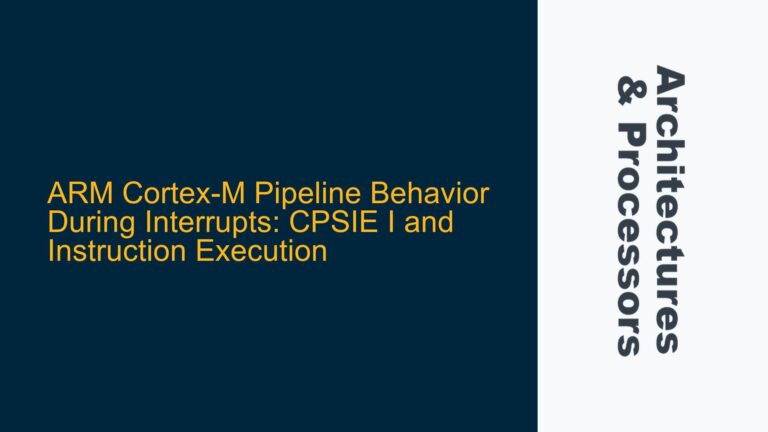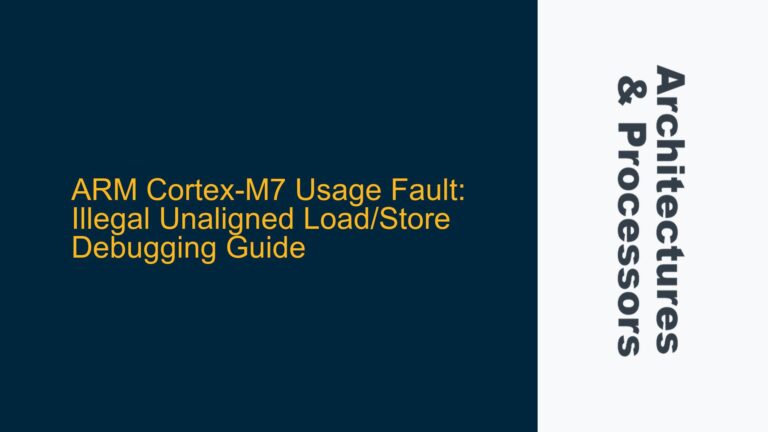Synchronous Abort During EL1 to EL0 Transition Due to MMU Misconfiguration
The core issue revolves around a synchronous abort exception occurring when attempting to switch from Exception Level 1 (EL1) to Exception Level 0 (EL0) on an AARCH64-based system, specifically while testing a custom kernel on QEMU emulating a Raspberry Pi 3. The transition from EL3 to EL1 during boot is successful, but the subsequent attempt to switch a kernel thread from EL1 to EL0 results in a synchronous abort. The error is likely tied to the Memory Management Unit (MMU) configuration, as indicated by the ESR (Exception Syndrome Register) value 0x92000050, which corresponds to a data abort from a lower exception level. This suggests that the MMU is either improperly configured or lacks the necessary permissions for user-mode (EL0) access to the memory regions in question.
The key challenge here is understanding the intricacies of the ARMv8-A exception level model, the role of the MMU in enforcing memory protection, and the precise steps required to configure the system for a safe transition from EL1 to EL0. The ESR value provides critical clues, but a deeper dive into the MMU setup, page table configuration, and exception handling mechanisms is necessary to resolve the issue.
ESR Analysis and MMU Permission Mismanagement
The ESR value 0x92000050 is a critical piece of information for diagnosing the issue. Breaking it down:
- The Exception Class (EC) field
0x25(binary100101) indicates a data abort from a lower exception level, which can occur in either AArch32 or AArch64 state. - The Instruction Specific Syndrome (ISS) field provides additional details about the abort. In this case, the ISS value
0x2000050suggests that the abort was caused by a memory access violation, likely due to insufficient permissions or an invalid page table entry.
The MMU is responsible for enforcing memory access permissions based on the current exception level and the configuration of the page tables. When transitioning from EL1 to EL0, the MMU must be configured to allow user-mode access to the relevant memory regions. This involves setting the appropriate Access Permissions (AP) and User/Kernel (AP[1]) bits in the page table entries. If these permissions are not correctly configured, any attempt by the user-mode thread to access memory will result in a data abort.
Additionally, the spsr_el1 and elr_el1 registers must be correctly set before executing the eret instruction to transition to EL0. The spsr_el1 register should reflect the desired processor state for EL0, including the execution state (AArch64 or AArch32) and the interrupt mask bits. The elr_el1 register should point to the entry point of the user-mode thread. Any misconfiguration here can also lead to unexpected behavior, including synchronous aborts.
Comprehensive MMU Configuration and Exception Handling Fixes
To resolve the issue, the following steps must be taken:
-
Verify MMU Configuration:
- Ensure that the page tables are correctly set up to map the memory regions required by the user-mode thread.
- Set the Access Permissions (AP) bits in the page table entries to allow user-mode access. For example, setting
AP[2:1]to0b11allows read/write access from both EL0 and EL1. - Ensure that the User/Kernel (AP[1]) bit is set to allow user-mode access. This is typically bit 6 in the page table entry for AArch64.
-
Check Page Table Entries:
- Validate that the page table entries for the memory regions accessed by the user-mode thread are marked as valid and have the correct attributes (e.g., Normal Memory, Device Memory).
- Ensure that the translation tables are properly aligned and that the base address of the page tables is correctly loaded into the
TTBR0_EL1register.
-
Configure Exception Handling:
- Set up the exception vector table to handle synchronous aborts and other exceptions. The vector table should be correctly aligned and mapped in memory.
- Implement a handler for data aborts that logs the ESR and ELR values for debugging purposes. This will help identify the exact cause of the abort.
-
Set Up
spsr_el1andelr_el1:- Before executing the
eretinstruction, ensure thatspsr_el1is configured with the desired processor state for EL0. This includes setting the execution state (AArch64), interrupt mask bits, and other relevant flags. - Set
elr_el1to the entry point of the user-mode thread. This should be the address of the function or code block that will execute in EL0.
- Before executing the
-
Test and Debug:
- Use a debugger to step through the transition from EL1 to EL0 and verify that the MMU configuration and register settings are correct.
- Monitor the ESR and ELR values in the exception handler to identify any issues with memory access or page table configuration.
By following these steps, the issue of synchronous aborts during the EL1 to EL0 transition can be resolved. The key is to ensure that the MMU is correctly configured to allow user-mode access to the necessary memory regions and that the processor state is properly set up before executing the eret instruction. This requires a thorough understanding of the ARMv8-A architecture, particularly the exception level model and the role of the MMU in memory protection.
Detailed MMU Configuration Example
Below is an example of how to configure the MMU for a user-mode thread in AArch64:
// Example: Setting up page tables for user-mode access
// Define memory regions and attributes
.equ USER_CODE_BASE, 0x0000_0000_4000_0000
.equ USER_DATA_BASE, 0x0000_0000_8000_0000
.equ PAGE_SIZE, 0x1000
// Set up page table entries
ldr x0, =USER_CODE_BASE
ldr x1, =USER_DATA_BASE
ldr x2, =PAGE_SIZE
// Configure page table entries for user code
orr x3, x0, 0x3 // Mark as valid and allow user-mode access
str x3, [x2]
// Configure page table entries for user data
orr x4, x1, 0x3 // Mark as valid and allow user-mode access
str x4, [x2, #8]
// Load base address of page tables into TTBR0_EL1
msr TTBR0_EL1, x2
// Enable MMU
mrs x5, SCTLR_EL1
orr x5, x5, 0x1 // Enable MMU
msr SCTLR_EL1, x5
This example demonstrates how to set up page table entries for user-mode access and enable the MMU. The key steps include marking the page table entries as valid, setting the appropriate access permissions, and loading the base address of the page tables into the TTBR0_EL1 register.
Conclusion
The synchronous abort during the EL1 to EL0 transition is a common issue when developing custom kernels for ARMv8-A architectures. The root cause is often related to MMU misconfiguration or insufficient permissions for user-mode access. By carefully configuring the MMU, setting up the page tables, and ensuring that the processor state is correctly initialized before transitioning to EL0, this issue can be resolved. Additionally, implementing robust exception handling and debugging mechanisms will help identify and address any further issues that may arise during development.






